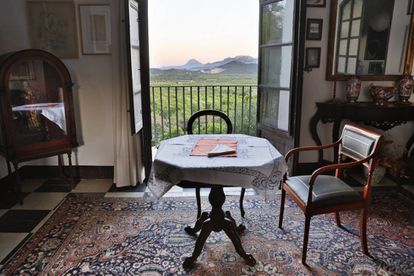
©EL PAÍS
L’ELCA DECLARADA BIEN DE INTERÉS CULTURAL
El pasado mes de enero, el pleno del Consell aprobó la declaración como Bien de Interés Cultural (BIC), con la categoría de lugar histórico, L’Elca, la casa del poeta Francisco Brines, quien faltó en 2021 a sus 89 años.
Esta masía se encuentra en el término municipal de Oliva (Valencia). Se encuentra rodeada de naranjos y desde el balcón puede divisarse el mar, recurso que fue una gran fuente de inspiración para los poemas del premio Cervantes.
La finca también fue lugar de recepción de numerosas tertulias de escritores y sede de la Fundación Francisco Brines, así como de su inmensa biblioteca.
Don Francisco Brines definió así su propia casa “se trata de una casa blanca y grande, situada en un ámbito celeste de purísimo azul y rodeada de la perenne juventud de los naranjos. Domina desde una ladera, sin altivez, un ancho valle, abierto al mar y mira la agrupada y densa sucesión de unas desnudas montañas que se hacen de plata antes de llegar al solemne Montgó. Este, colmo una vieja divinidad, alarga su cuerpo en perezosa e intemporal siesta, y ya dentro de los azules marinos recibe su definitivo bautizo: cabo de San Anonio”.
El Consell apunta que se trata de un legado importante del poeta, tanto a nivel bibliográfico, como pictórico y paisajístico. La finca se asentó en una villa romana que se encontraba rodeada de olivos. La edificación se levantó por la familia Avargues en el siglo XVII; a finales del siglo XIX, la propiedad fue adquirida por los Trénor y, posteriormente, por la familia Brines, que se dedicaba al comercio de la naranja durante los años cuarenta del siglo XX.
El poeta vivió en la finca durante los últimos años de su vida, tras una larga estancia en Madrid. Uno de sus mayores deseos era que su legado, patrimonio, miles de libros y obras de arte permanezcan en su masía, convirtiéndose en un futuro, en un centro de estudios y un espacio para la escritura.
El entorno de protección acotado por la declaración BIC abarca la casa principal, el mobiliario, la colección bibliográfica y pictórica, los elementos decorativos, la capilla, las edificaciones anexas, los jardines y la parcela donde se insertan todas las instalaciones.
__
L’ELCA DECLARED AN ASSET OF CULTURAL INTEREST
January, the plenary of the Consell approved the declaration as an Asset of Cultural Interest (BIC), with the category of historical place, L’Elca, the house of the poet Francisco Brines, who passed away in 2021 at the age of 89.
This farmhouse is located in the municipality of Oliva (Valencia). It is surrounded by orange trees and from the balcony you can see the sea, a resource that was a great source of inspiration for the poems of the Cervantes prize winner.
The estate was also the venue for numerous writers’ gatherings and the headquarters of the Francisco Brines Foundation, as well as its immense library.
Don Francisco Brines defined his own house as follows: “It is a large, white house, located in a heavenly environment of pure blue and surrounded by the perennial youth of the orange trees. It dominates from a hillside, without haughtiness, a wide valley, open to the sea and looks at the grouped and dense succession of naked mountains that become silver before arriving at the solemn Montgó. This, like an old divinity, lengthens its body in a lazy and timeless nap, and already within the blue sea receives its definitive baptism: Cape San Antonio.
The Consell points out that this is an important legacy of the poet, both bibliographically, pictorial and landscape. The estate was settled in a Roman villa that was surrounded by olive trees. The building was erected by the Avargues family in the 17th century; at the end of the 19th century, the property was acquired by the Trénor family and later by the Brines family, who were involved in the orange trade during the forties of the 20th century.
The poet lived on the estate during the last years of his life, after a long stay in Madrid. One of his greatest wishes was that his legacy, heritage, thousands of books and works of art remain in his farmhouse, becoming in the future, a study center and a space for writing.
The protected environment enclosed by the BIC declaration covers the main house, the furniture, the bibliographic and pictorial collection, the decorative elements, the chapel, the annex buildings, the gardens and the plot where all the facilities are located.
__

